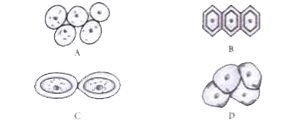Sclerenchyma tissue is a tissue
Living and non-mechanical
Dead and mechanical
Living and mechanical
Dead and non-mechanical
The correct Answer is:B
Step by step video, text & image solution for Sclerenchyma tissue is a tissue by Biology experts to help you in doubts & scoring excellent marks in Class 12 exams.
Updated on:21/07/2023Similar Questions
Knowledge Check
Assertion : The rigidity in leaf is due to sclerenchyma.
Reason : Sclerenchyma are dead tissue and provide mechanical strength.AIf both assertion and reason are true and reason is the correct explanation of assertion.BIf both assertion and reason are true but reason is not the correct explanation of assertion.CIf assertion is true but reason is false.DIf both assertion and reason are false.The cells of sclerenchyma tissue have their walls thickened due to which chemical substance?
ACelluloseBLigninCPectinDHemicelluloseAssertion : Sclerenchyma fibres constitute the major mechanical tissue of the plants.
Reason : The cells are thick walled and are made up of lignin.AIf both assertion and reason are true and reason is the correct explanation of assertion.BIf both assertion and reason are true but reason is not the correct explanation of assertion.CIf assertion is true but reason is false.DIf both assertion and reason are false.
What is an advantage of having collenchyma supportive tissue when sclerenchyma provides more structural support?
View SolutionA tissue is a group of similar cells held together by a cementing substance produced by them, for performing a specific function. There are two types of tissue in plants i.e., meristematic tissue and permanent tissue. Meristematic tissue are found in all growing parts of plants such as root and shoot tips. These are called apical meristem. The tissue occurs right from the birth of plant, are called primary meristems. Permanent tissue arise from meristematic tissue and constitute major portion of the plant body. These includes simple and complex tissues. Simple tissues are parenchyma, sclerenchyma and collenchyma, complex tissue are xylem and phloem.
Four students observed parenchyma tissue and drew following diagrams. Which one is correct?

View SolutionA tissue is a group of similar cells held together by a cementing substance produced by them, for performing a specific function. There are two types of tissue in plants i.e., meristematic tissue and permanent tissue. Meristematic tissue are found in all growing parts of plants such as root and shoot tips. These are called apical meristem. The tissue occurs right from the birth of plant, are called primary meristems. Permanent tissue arise from meristematic tissue and constitute major portion of the plant body. These includes simple and complex tissues. Simple tissues are parenchyma, sclerenchyma and collenchyma, complex tissue are xylem and phloem.
Parenchyma arises from
View SolutionA tissue is a group of similar cells held together by a cementing substance produced by them, for performing a specific function. There are two types of tissue in plants i.e., meristematic tissue and permanent tissue. Meristematic tissue are found in all growing parts of plants such as root and shoot tips. These are called apical meristem. The tissue occurs right from the birth of plant, are called primary meristems. Permanent tissue arise from meristematic tissue and constitute major portion of the plant body. These includes simple and complex tissues. Simple tissues are parenchyma, sclerenchyma and collenchyma, complex tissue are xylem and phloem.
Which cells have the ability to divide?
View SolutionA tissue is a group of similar cells held together by a cementing substance produced by them, for performing a specific function. There are two types of tissue in plants i.e., meristematic tissue and permanent tissue. Meristematic tissue are found in all growing parts of plants such as root and shoot tips. These are called apical meristem. The tissue occurs right from the birth of plant, are called primary meristems. Permanent tissue arise from meristematic tissue and constitute major portion of the plant body. These includes simple and complex tissues. Simple tissues are parenchyma, sclerenchyma and collenchyma, complex tissue are xylem and phloem.
The xylem in plants are responsible for
View Solution
